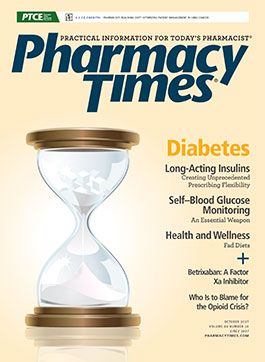Publication
Article
Pharmacy Times
Star Players on the Diabetes Care Team
Author(s):
The increasing incidence of diabetes is outpacing the number of health care providers skilled in caring for affected patients.
The increasing incidence of diabetes is outpacing the number of health care providers skilled in caring for affected patients.1 According to the CDC, an estimated 29.1 million individuals have diabetes in the United States, and another 86 million adults have prediabetes. If the trends continue, as many as 1 in 3 US adults could have diabetes within about 30 years.2,3
The good news is that pharmacists are well positioned for the challenging but satisfying work required to control our national diabetes crisis. “I see an opportunity for [pharmacists] to play a major role in advancing digital tools in patient care, especially in diabetes management,” wrote Lucienne Ide, MD, PhD, CEO of a software company focused on improving the lives of individuals living with chronic diseases, in the American Journal of Managed Care.3 “And with retail pharmacies such as CVS, Walgreens, and Walmart jumping into primary care and chronic disease management, [pharmacists will] have access to more opportunities.”
Multiple studies have shown that having pharmacists in diabetes management roles improves patient outcomes.4,5 It’s good to have hard evidence, but I’m sure you didn’t need studies to tell you this. You see positive outcomes all the time by providing education and medication therapy management to your patients with diabetes and by communicating with the other members of their health care team. To be star players on the diabetes care team, pharmacists need the right resources, such as those provided by Pharmacy Times®, including this Diabetes issue with articles on glucose self-monitoring, long-acting insulin, and diabetic neuropathy. Be sure to watch for our online resources, as well. In “Pharmacies Can Play Key Role in Diabetes Prevention” on pharmacytimes.com, Brooke Hudspeth, PharmD, CDE, notes 3 steps pharmacists can take to help prevent or reduce the incidence of diabetes:
- Promote awareness of prediabetes and the National Diabetes Prevention Program.
- Screen, test, and refer at-risk patients to a CDC-recognized lifestyle change program.
- Become CDC-recognized organizations to provide further assistance with treatment options.
Remember that you don’t need to wait for national provider status to increase your influence on the health care team today. Many pharmacists are exercising their freedom to learn new skills, obtain certifications, and expand their role, especially regarding the management of diabetes. In “2017 National Standards for Diabetes Self-Management Education and Support,” at pharmacytimes.com, author Jeannette Y. Wick, RPh, MBA, FASCP, covers The National Standards for Diabetes Self-Management Education and Support (DSMES), which have been updated for the first time in 3 years to reflect the latest recommended standards for diabetes care. DSMES describes how to structure education programs in all types of health care organizations, which team members to include, and appropriate curricula.
We also have a thorough online Diabetes Resource Center at pharmacytimes.com/resource-centers. For continuing education, go to pharmacytimes.org, and from the top navigation bar, select the “Topic” drop-down menu and click “Diabetes.”
With its extensive topic and news coverage, as well as comprehensive content delivery platforms, Pharmacy Times® strives to be your best resource on pharmacy to help you provide optimal patient care. October is celebrated as American Pharmacists Month to acknowledge the significant impact pharmacists have on their communities and health care teams. So, please join Pharmacy Times® and your peers in the celebration by using #ThankAPharmacist on social media. We appreciate and value your work in preventing and treating far-reaching diseases such as diabetes and setting our nation on a path toward better health. When pharmacists take steps to improve the care of patients with diabetes, their combined effort helps millions of individuals.
Thank you for reading!
Mike Hennessy, Sr
Chairman and CEO
References
- Preidt R. Shortage of doctors who treat diabetes looming. US News & World Report website. health.usnews.com/health-news/articles/2014/06/20/shortage-of-doctors-who-treat-diabetes-looming. Published June 20, 2014. Accessed September 8, 2016.
- Diabetes. CDC website. cdc.gov/chronicdisease/resources/publications/aag/diabetes.htm. Updated July 25, 2016. Accessed September 8, 2016.
- Ide L. Expanding pharmacist provider status can improve diabetes management. ajmc.com website. ajmc.com/contributor/lucienne-ide-md-phd/2015/12/expanding-pharmacist-provider-status-can-improve-diabetes-management. Published December 17, 2015. Accessed September 8, 2016.
- Ip EJ, Shah BM, Yu J, et al. Enhancing diabetes care by adding a pharmacist to the primary care team. Am J Health Syst Pharm. 2013;70(10):877-886. doi: 10.2146/ajhp120238.
- Edwards HD, Webb RD, Scheid DC, et al. A pharmacist visit improves diabetes standards in a patient-centered medical home (PCMH). Am J Med Qual. 2012;27(6):529-534. doi: 10.1177/1062860612444304.







